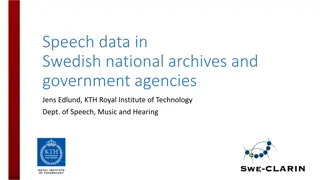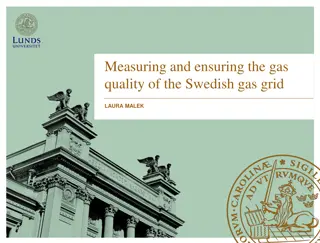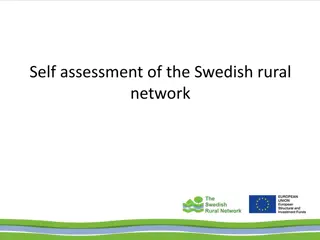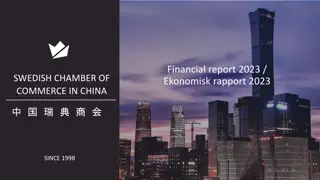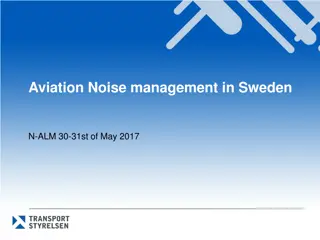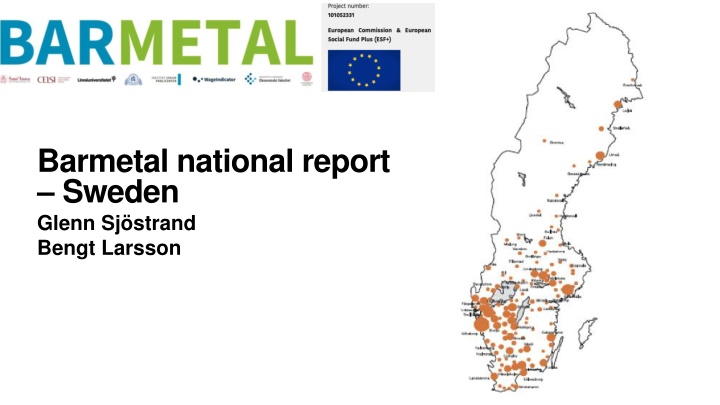
Structural and Institutional Settings of Swedish Industry
Swedish industry heavily relies on exports, with a significant presence in manufacturing, particularly in the automotive sector. The country's industrial relations system is characterized by strong trade unions and employer associations, leading to high levels of cooperation and competitiveness. National policies and social dialogue play a crucial role in shaping digitalization and development policies in Sweden.
Download Presentation

Please find below an Image/Link to download the presentation.
The content on the website is provided AS IS for your information and personal use only. It may not be sold, licensed, or shared on other websites without obtaining consent from the author. If you encounter any issues during the download, it is possible that the publisher has removed the file from their server.
You are allowed to download the files provided on this website for personal or commercial use, subject to the condition that they are used lawfully. All files are the property of their respective owners.
The content on the website is provided AS IS for your information and personal use only. It may not be sold, licensed, or shared on other websites without obtaining consent from the author.
E N D
Presentation Transcript
Barmetal national report Sweden Glenn Sj strand Bengt Larsson
The Swedish industry: Structural and Institutional settings Sweden is a small and open economy highly dependent on exports and exporting industries. employees About 5,2 million of the population of appr. 10,5 million are in the labour force. The unemployment rate is 8,5 %. Around 11 % of Swedish employees are in manufacturing (incl. mining), which is close to the EU-27 mean, and appr. 14 % of Swedish employers are in the manufacturing sector. This is a rather stable number over the last decades. About 820 000 work within the industrial sector. The automotive industries are relatively large: ca. 1050 companies are in the vehicle industry (the majority are suppliers) with about 74 000 workers (166 000 workers incl. subcontractors). The export value about 253 billions 2022. (MobilitySweden.se) Many former Swedish owned companies have been sold to international companies, but manufacture and especially R&D have stayed in Sweden. Today 60 % of the companies are part of business groups. The vehicle industry has had about 5 % above average increases in wages compared to the industrial sector, and the blue collar workers have a more compressed wage structure than white collars. Women earns 99,7% of the men in the industry 2015 (Andersson et.al 2016).
National policies and the role of social dialogue for shaping DAD policies There has been a strong political and social partner commitment from Swedish employers and the unions during the last decade. Even though general and sectoral collective agreements does not specifically regulate DAD issues, the general cooperation and negotiation at crossectoral level has been successful to stay ahead and competitive. Union influence on digitalization of work is mainly exercised through the codetermination process, specified by law and the crossectoral Development Agreement from 1985. Also, some occasional statements from the IF Metall s joint CAs, concerning sustainable work , under 19 Measures for developing the company, which indicates some general joint views and the ambition to solve digital and environmental transitions locally, and for competence development in the automotive industry (in the blue collar agreement). The Swedish industrial relations system The industrial relations are characterized by strong trade unions and employer associations negotiating collective agreements with a high degree of autonomy from the state, and with wide bargaining coverage and relatively low levels of conflict (the exception right now is Tesla and IF Metall who have been in conflict over collective agreements since 24th of October 2023). There is a large welfare state based on social democratic traditions, however, as in other Nordic countries Sweden have seen the introduction of more liberal features, such as increased fees in the unemployment insurance funds, a loosening of employment regulation (with more temporary contracts), and an organized decentralization of collective bargaining from the 1980s onwards. Swedish trade unions are strong and are by tradition organized primarily on an occupational/industry basis, in three class-based confederations one each for blue-collar (LO), white-collar workers (TCO), and for academically trained professionals (SACO). About 90% of all employed are covered by collective agreements and the general level of union membership is about 70% (Medlingsinstitutet 2023). The membership of Swedish employers in the employers organization (Svenskt N ringsliv) is also about 90% (Medlingsinstitutet 2023).
Swedish national policies and the role of social dialogue for shaping DAD policies There has been a strong political and social partner commitment from Swedish employers and the unions during the last decade. Even though general and sectoral collective agreements does not specifically regulate DAD issues, the general cooperation and negotiation at crossectoral level has been successful to stay ahead and competitive. Union influence on digitalization of work is mainly exercised through the codetermination process, specified by law and the crossectoral Development Agreement from 1985. Also, some occasional statements from the IF Metall s joint CAs, concerning sustainable work , under 19 Measures for developing the company, which indicates some general joint views and the ambition to solve digital and environmental transitions locally, and for competence development in the automotive industry (in the blue collar agreement).
Case study 1: Volvo Cars Body Components, Olofstr m Olofstr m, with appr. 2400 employees produce different metal parts for Geely cars (the main owner), mostly for Volvo, Polestar, Lynk & Co, and Zeekr. (41% of all workers in Olofstr m works at Volvo). Interviews were performed with the Head of R&D, the white collar workers union (Unionen), and two shop floor workers. The production is mainly pressed metal blades for car parts such as the hood, roof, and doors. The headquarter is in Gothenburg and the Torslanda factory where the car parts from Olofstr m are assembled. Volvo Cars Body Components, Olofstr m Four other productions sites are located in Sweden and other main production plants are in China, Belgium, USA, and a new factory is set up in Slovakia.
Case 2: Rottne Industri AB, Rottne Appr. 230 employees and three production sites in Sweden. They are producing forest machinery such as harvesters, forwarders, harvester heads and simulators. Interviews with the HR-manager, the Manager of Product Development, the chair of the white collar workers union (Unionen), the blue collar workers union (IF Metall), and two shop floor workers. Company 3: An additional interview with Head of R&D at Kalmar Industries, Ljungby, (a part of Cargotec). Appr. 470 employees. Produces lift trucks, heavy forklifts, reachstackers and master container handlers. They also produce trucks in Finland, Poland, Malaysia and USA.
Comparative findings: Status and effects of DAD Both employers and unions have much consensus in that they advocate further digitalization, automation, and decarbonization to keep up with international competition and save jobs. However, the enthusiasm regarding the potential technological development is somewhat more balanced by discussion of the challenges and risks particularly from the blue-collar trade union side. The partners also points out that the social partners, the government, and universities must cooperate to strengthen the steps and measures taken to come to grips with the digital competence deficiencies that is hampering Swedish economic growth. For instance, the blue-collar union IF Metall emphasize the need to consider social justice also in relation to climate transition, so that their members are not hit by job losses and get the education/training opportunities needed to keep up with the change.
Company-level case studies: tackling DAD challenges Rottne and Volvo (also Kalmar) clearly have well reasoned strategies to implement digital technologies and know rather well how to argue for why certain technologies are used and others are not. The level of implemented DAD practices and technologies in the three studied companies are varied. Automation have been a concern for a long time in all studied companies but more intensively used digitalization is a more recent technology. For Volvo it is of vital interest to electrify, but for Rottne electrification is currently a non-issue as their vehicles are used way out in the woods with no access to charging systems. Decarbonization is perhaps the main challenge that has been taken on most strongly at Volvo. No more research and development is spent at old diesel and petrol technology. All investments are directed towards electric cars. Volvo has long used robotics and automation in the production. Also, all sorts of administrative, maintenance, HR and enterprise planning (ERP) systems are used. Digitalization is mainly used in the automated parts of the productions lines and automation for robotics and production units. Rottne is currently mainly investing in a new ERP-system. Also, their vehicles are linked to internet systems to be constantly monitored as regards their need of maintenance and support for problem solving at distance. A digitalised stock system is used with coordinated inventories and time coordinated deliveries to the production-lines.
Company-level case studies: trade union involvement There is a difference in union involvement based on the size of the companies and unions, the products, but also in traditions, between Volvo and Rottne. At Volvo both IF Metall and Unionen are heavily involved in the DAD-strategies of the site. One of the IF Metall representatives is a member of the company bord located in China and as such have great power and responsibility for strategies on these issues. There are possibilities for the workers to have a say in changes of the organization of the work, working conditions and the like, even though most of the shop floor workers are not directly active in the involvement concerning DAD they leave that to union representatives. Issues of implementing new technologies, training and competence building are mainly based on company needs and blue-collar workers accommodation to these not negotiations with the unions. Most workers seem adjust to the situation. The active support of the workers are none the less necessary for the implementation of new technologies, for instance the new ERP-system at Rottne has not been able to be fully implemented due to some lack of training and resistance from parts of the working staff.
Comparative findings comparing Sweden with Poland and Hungary: Structural difference with Poland: Poland has three main national trade unions and some 12,000 trade union organizations, Hungary has five confederations of unions comprising some 51 union organizations, whereas Sweden has three main national trade organizations (LO, TCO & Saco) and 57 trade union organizations. Sectoral collective bargaining does not exist in Poland, but very much so in Sweden and to a large degree in Hungary where it s decentralized to the company level. Immigration creates challenges for the recognition of competences and qualifications, on top of language issues, that are similar between the countries. The need for training, retraining, up-skilling, re-skilling seem to be similar, but there seem to be instances of dropping out of training to a higher extent in Poland. The decline of members in unions are issues in all three countries and it affects the possibilities to take part in central bargaining and cover all issues relating to DAD.
Conclusive status and effects for workers and bargaining over DAD The studied companies and unions have strategies for digitalization, automation and decarbonization albeit to different degrees and with different goals depending among others on market and size of company. Changed working tasks, replacing/releasing workers from monotonous and administrative work, seem to be arguments to develop DAD from both the employers and the unions. Training, retraining, up-skilling and re-skilling and recruitment is of most importance to keep up and are parts of the union and bargaining. But unions fear increased control and surveillance of work processes, quality and time efficiency and workers sometimes feel frustrated with slow and troublesome implementation of DAD they have to learn by doing.






